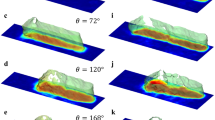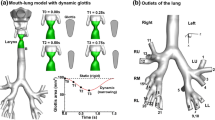Abstract
Nasal emission is a speech disorder where undesired airflow enters the nasal cavity during speech due to inadequate closure of the velopharyngeal valve. Nasal emission is typically inaudible with large velopharyngeal openings and very distorting with small openings. This study aims to understand how flow characteristics in the nasal cavity change as a function of velopharyngeal opening using computational fluid dynamics. The model is based on a subject who was diagnosed with distorting nasal emission and a small velopharyngeal opening. The baseline geometry was delineated from CT scans that were taken, while the subject was sustaining a sibilant sound. Modifications to the model were done by systematically widening or narrowing the velopharyngeal opening while keeping the geometry constant elsewhere. Results show that if the flow resistance across the velopharyngeal valve is smaller than resistance across the oral constriction, flow characteristics such as velocity and turbulence are inversely proportional to the size of the opening. If flow resistance is higher across the velopharyngeal valve than the oral constriction, turbulence in the nasal cavity will be reduced at a higher rate. These findings can be used to generalize that the area ratio of the velopharyngeal opening to the oral constriction is a factor that determines airflow characteristics and subsequently its sound during production of sibilant sound. It implies that the highest level of turbulence in the nasal cavity, and subsequently the sound that will likely be perceived as the most severe nasal emission is produced when the size of openings is equal.










Similar content being viewed by others
References
Bechara W, Lafon P, Bailly C, Candel S (1994) Application of a k-epsilon turbulence model to the prediction for simple and coaxial free jets. J Acoust Soc Am 97:3518–3531. https://doi.org/10.1121/1.412438
Bunton K (2015) Effects of nasal port area on perception of nasality and measures of nasalance based on computational modeling. Cleft Palate Craniofac J 52:110–114. https://doi.org/10.1597/13-126
Cimbala YA, Cengel JM (2003) Fluid mechanics: fundamentals and applications, 1st edn. McGraw-Hill, New York
Curle N (1955) The influence of solid boundaries upon aerodynamic sound. Proc R Soc A Math Phys Eng Sci 231:505–514. https://doi.org/10.1098/rspa.1955.0191
Dalston RM, Warren DW, Dalston ET (1991) Use of nasometry as a diagnostic tool for identifying patients with velopharyngeal impairment. Cleft Palate Craniofac J 28:184–189
Ferziger JH, Perić M (2012) Computational methods for fluid dynamics, 3rd rev. Springer, Berlin
Hinze JO (1975) Turbulence, 2nd edn. MacGraw-Hill, New York
Hixon TJ, Weismer G, Hoit JD (2014) Preclinical speech science: Anatomy, physiology, acoustics, perception. Plural Publishing, San Diego
Jones WP, Launder BE (1972) The prediction of laminarization with a two-equation model of turbulence. Int J Heat Mass Transf 15:301–314. https://doi.org/10.1016/0017-9310(72)90076-2
Kähler CJ, Scharnowski S, Cierpka C (2012) On the uncertainty of digital PIV and PTV near walls. Exp Fluids 52:1641–1656. https://doi.org/10.1007/s00348-012-1307-3
Krane MH (2005) Aeroacoustic production of low-frequency unvoiced speech sounds. J Acoust Soc Am 118:410–427. https://doi.org/10.1121/1.1862251
Kummer AW, Curtis C, Wiggs M et al (1992) Comparison of velopharyngeal gap size in patients with hypernasality, hypernasality and nasal emission, or nasal turbulence (rustle) as the primary speech characteristic. Cleft Palate Craniofac J 29:152–156
Kummer AW, Briggs M, Lee L (2003) The relationship between the characteristics of speech and velopharyngeal gap size. Cleft Palate Craniofac J 40:590–596
Ladefoged P (1963) Some physiological parameters in speech. Lang Speech 6:109–119. https://doi.org/10.1177/002383096300600301
Lien K, Monty JP, Chong MS, Ooi A (2004) The entrance length for fully developed turbulent channel flow. In: 15th Australasian fluid mechanics conference (Sydney, Australia)
McWilliams BJ, Morris HL, Shelton RL (1990) Cleft palate speech. Mosby Elsevier Health Science, Philadelphia
Peterson-Falzone SJ, Trost-Cardamone J, Karnell MP, Hardin-Jones MA (2016) The Clinician’s guide to treating cleft palate Speech-E-Book. Elsevier Health Sciences, Amsterdam
Proudman I (1952) The generation of noise by isotropic turbulence. Proc R Soc A Math Phys Eng Sci 214:119–132. https://doi.org/10.1098/rspa.1952.0154
Richardson LF (1911) The approximate arithmetical solution by finite differences of physical problems involving differential equations. Philos. Trans R Soc London Ser A 210:307–357. https://doi.org/10.1098/rsta.1911.0009
Rodi W (1991) Experience with two-layer models combining the k-epsilon model with a one-equation model near the wall. In: 29th Aerospace Sciences Meeting, AIAA 91-0216
Rollins M, Oren L (2019) Aerodynamic flow variables as a function of velopharyngeal gap size. In: 177th Meeting: Acoustical Society of America, vol 36, p 060001. https://doi.org/10.1121/2.0001022
Sarkar S, Hussaini MY (1993) Computation of the sound generated by isotropic turbulence. NASA Report 191543, ICASE Report No. 93–74
Shadle CH (1991) The effect of geometry on source mechanisms of fricative consonants. J Phonet 19:409–424
Shih TH, Liou WW, Shabbir A et al (1995) A new K-epsilon eddy viscosity model for high Reynolds number turbulent flows: model development and validation. Comput Fluids. https://doi.org/10.1016/0045-7930(94)00032-T
Sundström E, Oren L (2019a) Pharyngeal flow simulations during sibilant sound in a patient-specific model with velopharyngeal insufficiency. J Acoust Soc Am 145:3137–3145. https://doi.org/10.1121/1.5108889
Sundström E, Oren L (2019b) Sound production mechanisms of audible nasal emission during the sibilant /s/. J Acoust Soc Am 146:4199–4210. https://doi.org/10.1121/1.5135566
Sundström E, Tomac M (2019) Synchronization and flow characteristics of the opposed facing oscillator pair in back-to-back configuration. Flow Turbul Combust. https://doi.org/10.1007/s10494-019-00064-6
Sundström E, Semlitsch B, Mihăescu M (2018a) Acoustic signature of flow instabilities in radial compressors. J Sound Vib 434:221–236. https://doi.org/10.1016/j.jsv.2018.07.040
Sundström E, Semlitsch B, Mihăescu M (2018b) Generation mechanisms of rotating stall and surge in centrifugal compressors. Flow Turbul Combust 100:705–719. https://doi.org/10.1007/s10494-017-9877-z
Warren DW (1979) Perci: a method for rating palatal efficiency. Cleft Palate J 16:279
Acknowledgements
The authors acknowledge the support of NIH Grant No. K25DC014755.
Author information
Authors and Affiliations
Corresponding author
Ethics declarations
Conflict of interest
The authors declare that they have no conflict of interest that could influence their work.
Rights and permissions
About this article
Cite this article
Sundström, E., Boyce, S. & Oren, L. Effects of velopharyngeal openings on flow characteristics of nasal emission. Biomech Model Mechanobiol 19, 1447–1459 (2020). https://doi.org/10.1007/s10237-019-01280-9
Received:
Accepted:
Published:
Issue Date:
DOI: https://doi.org/10.1007/s10237-019-01280-9




